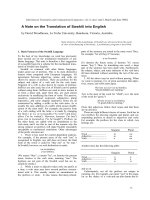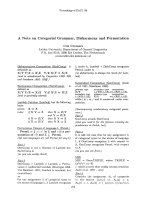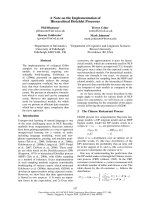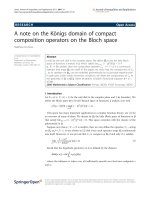A note on Ditrichum pusillum (Hedw.) hampe, (Ditrichaceae, Musci), in Turkey
Bạn đang xem bản rút gọn của tài liệu. Xem và tải ngay bản đầy đủ của tài liệu tại đây (114.5 KB, 5 trang )
Turk J Bot
28 (2004) 443-447
â TĩBTAK
Research Note
A Note on Ditrichum pusillum (Hedw.) Hampe,
(Ditrichaceae, Musci), in Turkey
Gỹray UYAR
Zonguldak Karaelmas University, Faculty of Science & Arts, Department of Biology, 67100, Zonguldak - TURKEY
Tamer KEầEL
Krkkale University, Faculty of Science & Arts, Department of Biology, 71100, Krkkale - TURKEY
Received: 24.04.2003
Accepted: 10.11.2003
Abstract: Ditrichum pusillum (Hedw.) Hampe has been collected for the first time from the Western Black Sea region of Turkey. A
description of the species is given, along with notes on the ecology and a discussion of the phytogeographic significance. This note
will provide better knowledge of the moss flora of Turkey.
Key Words: Moss flora, Ditrichum, Ditrichaceae, phytogeography, Turkey.
Tỹrkiyedeki Ditrichum pusillum (Hedw.) Hampe, (Ditrichaceae, Musci) Tỹrỹ ĩzerine Bir Not
ệzet: Ditrichum pusillum (Hedw.) Hampe Tỹrkiyenin Bat Karadeniz Bửlgesinden ilk kez toplanmfltr. Tỹrỹn ayrntl bir tanmlamas
ile birlikte fitocoÔrafik ửnemi ve ekolojisi de verilmifltir. Bu not Tỹrkiye Karayosunlar florasnn daha iyi bilinmesine katk
saÔlayacaktr.
Anahtar Sửzcỹkler: Karayosunu floras, Ditrichum, Ditrichaceae, bitkicoÔrafyas, Tỹrkiye.
Introduction
Ditrichum pusillum (Hedw.) Hampe was first recorded
from MuÔla (C12), on low ground, on road side, on soil
banks, ca. 130 m, 22.04.1992, T. 3524. (Dỹll, 1984;
ầetin, 1988; Frey & Kỹrschner, 1991; Tonguỗ 2000).
However, this species has never been collected from the
Western Black Sea region of Turkey. In this study
Ditrichum pusillum (Hedw.) Hampe is recorded for the
first time from the Western Black Sea region (ầetin &
Yurdakulol, 1985; ầetin & Yurdakulol, 1988; ầetin &
Uyar, 1997; Keỗeli & ầetin, 2000; Uyar & ầetin, 2001;
ầetin et al., 2002).
Ditrichum pusillum (Hedw.) Hampe, Flora 50: 182.
1867.
Basionym: Didymodon pusillus Hedw., Spec. Musc.
104. 1801.
Syn.: Ditrichum tortile (Schrad.) Brockm., Laubm.
Meckl., 1869. (Pedrotti 2001).
Plants tufted to scattered, yellow-green to dark
green. Stems erect, leaves somewhat spreading and
sometimes branched, 5-10 mm high, rarely higher.
Leaves erect to spreading, 1-2.5 mm long, leaf apex
flexuose, from lanceolate base narrowed into fine,
channelled subula; margin plane or incurved below,
recurved and bistratose above, plane and slightly obtusely
denticulate at apex; costa percurrent, in cross section
near the base with a narrow stereid band, in upper part
of leaf with a dorsal stereid band and a small group of
stereid cells above the guide cells, leaf cells near apex,
cells narrow, elongate-rectangular below, at extreme
base slightly widened, in upper part of leaves cells
shorter; Inner perichaetial leaves from ovate base, long
and narrowly subulate. Seta 1-1.5 cm long, brown.
Capsule straight and erect or nearly so, brown, smooth,
ovoid to cylindrical, peristome, 0.2-0.3 mm long, the
teeth often twisted, divided nearly to the base, often
443
A Note on Ditrichum pusillum (Hedw.) Hampe, (Ditrichaceae, Musci), in Turkey
united at nodes below, papillose or more often obliquely
striate, shorter and darker in colour bordering the
mouth; operculum conical-rostrate 0.5-0.8 mm long.
Spores 11-15 àm, pale smooth or almost so, mature in
late autumn. Rhizoids with brownish gemmae, up to 150
x 100 à in size (Figure 1).
This species is distinguished from related species by
dioecious conditions, leaves gradually tapering, in the
upper part subulate, not squarrose and not crisped;
margins narrowly recurved denticulate above; seta
brown; operculum 0.5-0.8 mm long, peristome teeth
0.2-0.4 mm long, papillose often united at base; spores
smooth 11-15 àm and the presence of rhizoidal gemmae
(Smith, 1978; Watson, 1981; Nyholm, 1986; Lawton,
1971; Frey, et al., 1995)
World distribution: Europe: Austria, Belgium, Great
Britain, Czechoslovakia, Denmark, Finland, France,
Germany, Ireland, Switzerland, Netherlands, Hungary,
Iceland, Italy, Yugoslavia, Norway, Poland, Romania.
Russia and the former USSR: Northern region, Baltic
region, Central region, South-western region, Caucasus.
Asia: North-east Asia, Central Asia, South-west Asia
(Jordan).
Africa: North Africa, Macaronesia with Azores.
America: North America including Greenland, Central
America.
Specimen examined: Dỹzce; Akỗakoca mountains;
Bacakl plateau hill, near stream, in Fagus orientalis
Lipsky forest, mixed with Carpinus betulus L., Castanea
sativa Miller., Abies bornmuelleriana Mattf., Pinus
sylvestris L., Pinus nigra Arn., Taxus baccata L.,
Laurocerasus officinalis Roemer. on wet soil, alt. 800 m,
6. ix. 2001, (herb. Uyar) UYAR 441.
Ecology: Plants on damp sandy soil, schistose craggy
rocks, slopes, paths and road sides and fallow fields in
sand pits below the subalpine belt.
Associated bryophyte species in the same habitat:
Poganatum aloides (Hedw.) P. Beauv. var. minimum
(Crome.) Mol., Dicranella heteromalla (Hedw.) Schimp.,
Ditrichum heteromallum (Hedw.) Britt., Pohlia elongata
var. elongata Hedw., Philonotis tomentella Mol.,
444
Drepanocladus revolvens (Sm.) Warnst., Lunularia
cruciata (L.) Dumort. ex Lindb., Metzgeria conjugata
Lindb. and also Diplophyllum albicans (L.) Dumort.
The study area is the A2 gridsquare in the system
adopted by Henderson (1961) (Figure 2). This region has
a typical oceanic climate. The precipitation regime in the
study area is oceanic climate type 2. There is no drought
season in this climate type (Akman, 1990).
Forest vegetation consists of mainly Fagus orientalis
Lipsky, Carpinus betulus L., Coryllus avellana L., Castanea
sativa Miller., Abies nordmanniana (Steven) Spach., Pinus
sylvestris L., Pinus nigra L., Taxus baccata L., Prunus
laurocerasus L. and Rhododenron ponticum L. in the
study area.
Discussion
Although this species was found almost all over
Europe, in south-west Asia it was only found in Jordan by
El-Oqlah et al. (1988). As is known, Turkey is a transition
zone between Europe and the Middle East for many
plants and animals. It is therefore expected to find this
species in Turkey. It was firstly recorded in MuÔla, which
is ca. 800 km away from the recent study area. In our
opinion, the reason for there being no record for
Ditrichum pusillum between these localities could be that
floristic studies on moss flora of Turkey are disorganised
and localised. We hope that regional studies will be
undertaken to complete the moss flora of Turkey in the
near future. The distance between the old locality, MuÔla,
and the new locality (Dỹzce; Akỗakoca mountains) and
different extreme habitats indicate a high probability of
its being found in the other fields not studied previously.
Acknowledgements
We would like to thank the curator of the herbarium
of (S) L. Hedenọs, for his helpful support in the
identification and checking with herbarium specimens and
we also thank the Research Fund of Zonguldak Karaelmas
University (Project number: 2000-13-03-10) for its
financial support.
1 mm
10 mm
G. UYAR, T. KEÇEL‹
b
79
e
f
g
µm
58 µm
2.5 mm
a
c
72 µm
d
125 µm
0.2 mm
12.5 µm
0.8 mm
175 µm
k
h
i
j
l
100 µm
Figure 1. Ditrichum pusillum.
a) Habit wet
d) Between basal and upper laminal cellse)
g) Cross section of leaf
j) Exothecial cells
b) Leaves
e) Upper cells
h) Operculum
k) Spores
c) Basal laminal cells
f) Capsule
i) Peristome
l) Rhizoidal gemmae
445
A Note on Ditrichum pusillum (Hedw.) Hampe, (Ditrichaceae, Musci), in Turkey
Zonguldak
N
Gökgöl
Ere¤li
BLACK SEA
Gülüç Stream
Devrek
Alapl›
Ala
pl›
Sivri Hill
544 m
E¤erci
St
re
am
K›z›l Hill
1478 m
Aktafl Hill Keza¤›l Hill
904 m
632 m
nta
Akç
Kaplandere Hill
1169 m
Mo
ak
oca
Bolu S
tream
1132 m
Kaynatmadoru¤u Hill
u
Hill
i n s Bacakl›yayla
1637 m
m
trea
en S
Mel
Y›¤›lca
Çal Hill
Tüllükirifl Hill
1893 m
1657 m Çeledoru¤u Hill
1981 m
am
ar D
sanl
Ha
Karadikmen Hill
1388 m
Düzce
Dikmen Hill
1204 m
Bolu
Melen Lake
am
öy D
Gölk
Ab
a
nt
Düzce
2
re
am
1
A
St
nu
M
n
ur
eam
Str
Baltaca
ou
4
8
12
16 20 km
ns
B
6
7
M
ud
ake
tL
an
Ab
i
ta
0
C
11
12
3
4
8
9
13
14
5
10
15
100 200 300 km
Figure 2. Distribution of Ditrichum pusillum(▲) in Turkey and grid system adopted by Henderson (1961).
References
Akman Y 1990. ‹klim ve Biyoiklim. Ankara: Palme Yay›n Da¤›t›m.
Çetin B 1988. Checklist of the mosses of Turkey. Lindbergia 14: 15-23.
Çetin B & Yurdakulol E (1985). Gerede – Aktafl (Bolu) Ormanlar›n›n
Karayosunlar› (Musci) Floras›. Do¤a Bilim Dergisi A2, 9: 29-39.
Çetin B & Uyar G (1997). The Moss Flora of Sinop and Its Environs
(Ayanc›k, Boyabat, and Gerze). Tr J of Botany 21: 231-244.
Çetin B & Yurdakulol E (1988). Yedigöller Milli Park› Karayosunlar›
Floras›. Do¤a Tu Botanik D 12: 128-146.
Çetin B, Unç E & Uyar G (2002). The Moss Flora of Ankara –
K›z›lcahamam – Çamkoru and Çaml›dere Districts. Tr J of Botany
26: 91-101.
446
G. UYAR, T. KEầEL
Dỹll R (1984). Distribution of the European and Macaronesian Mosses
(Bryophytina) Part 1. Bryologshe Beitrọge Band 4. Rheurdt.
Nyholm E (1986). Illustrated flora of Nordic mosses Fascicle 1.
Stockholm: The Nordic Bryological Society.
ElOqlah AA, Frey W & Kỹrschner H (1988). The Bryophyte Flora of
Trans-Jordan. A Catalogue of Species and Floristic Elements.
Willdenowia 18: 253-279.
Pedrotti CC. (2001). New Check-list of the Mosses of Italy. Fl Medit 11:
23-107.
Frey W & Kỹrschner H (1991). Conspectus Bryophytorum Orientalum
et Arabicorum. Berlin: Bryophytorum Bibliotheca Band 39.
Frey W, Frahm JP, Fischer E & Lobin W (1995). Kleine
Kryptogamenflora, Die Moos und Franplanzen Europas.
Stuttgart: Gustav Fischer Verlag.
Henderson DM (1961). Contributions to the Bryophyte Flora of Turkey
IV. Notes Roy Bot Gard Edinb 23: 263-278.
Keỗeli T & ầetin B (2000). The Moss Flora of ầankr Eldivan
Mountain. Tr J of Botany 24: 249258.
Smith AJE (1978). The Moss Flora of Britain and Ireland. Cambridge:
Cambridge University Press.
Tonguỗ ệ (2000). Some moss records from the Aegean and
Mediterranean region of Turkey. OT Sistematik Botanik Dergisi
7(2): 209-215.
Uyar G & ầetin B (2001). The Moss Flora of Ankara Kzlcahamam
SoÔuksu National Park. Tr J of Botany 25: 261- 273.
Watson EV (1981). British Mosses and Liverworts, Third Edition.
Cambridge: Cambridge University Press.
Lawton E (1971). Moss Flora of the Pacific Northwest. Tokyo: Journal
of the Hattori Botanical Laboratory. Suppl. No: 1.
447









